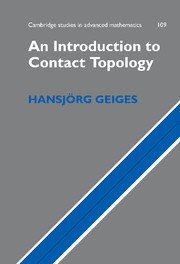Book contents
- Frontmatter
- Contents
- Preface
- 1 Facets of contact geometry
- 2 Contact manifolds
- 3 Knots in contact 3—manifolds
- 4 Contact structures on 3—manifolds
- 5 Symplectic fillings and convexity
- 6 Contact surgery
- 7 Further constructions of contact manifolds
- 8 Contact structures on 5—manifolds
- Appendix A The generalised Poincaré lemma
- Appendix B Time-dependent vector fields
- References
- Notation index
- Author index
- Subject index
4 - Contact structures on 3—manifolds
Published online by Cambridge University Press: 05 November 2009
- Frontmatter
- Contents
- Preface
- 1 Facets of contact geometry
- 2 Contact manifolds
- 3 Knots in contact 3—manifolds
- 4 Contact structures on 3—manifolds
- 5 Symplectic fillings and convexity
- 6 Contact surgery
- 7 Further constructions of contact manifolds
- 8 Contact structures on 5—manifolds
- Appendix A The generalised Poincaré lemma
- Appendix B Time-dependent vector fields
- References
- Notation index
- Author index
- Subject index
Summary
‘Singularity is almost invariably a clue.’
Arthur Conan Doyle, The Boscombe Valley MysteryThroughout the present chapter, M will denote a connected, closed, orientable 3—manifold. Our first major aim here is to prove the one-to-one correspondence between isotopy classes of so-called overtwisted contact structures on M on the one hand, and homotopy classes of tangent 2—plane fields on M on the other.
This programme is carried out in the following steps. In Section 4.1 I present what is essentially Martinet's [175] proof of the existence of a contact structure on every 3—manifold. This construction is based on the surgery description of 3—manifolds due to Lickorish and Wallace (Thm. 1.7.5). The key point is to show how suitable contact forms defined near the boundary of a solid torus can be extended over the whole solid torus. This will enable us to perform Dehn surgeries (along transverse knots) on contact 3—manifolds. For this extension procedure we use an approach due to Thurston and Winkelnkemper [233]; this yields a slight simplification of Martinet's original construction.
In Section 4.2 we show that every orientable 3—manifold is parallelisable and then build on this to classify cooriented tangent 2—plane fields up to homotopy.
In Section 4.3 we study the so-called Lutz twist, a topologically trivial Dehn surgery on a contact manifold (M, ξ) which yields a contact structure ξ′ on M that is not, in general, homotopic (as 2—plane field) to ξ.
- Type
- Chapter
- Information
- An Introduction to Contact Topology , pp. 130 - 267Publisher: Cambridge University PressPrint publication year: 2008

